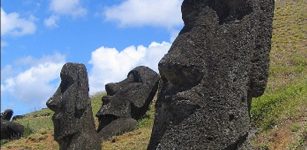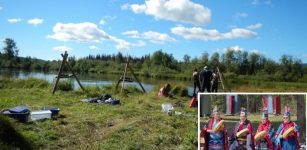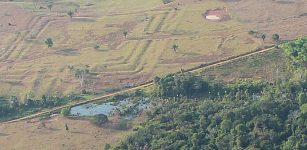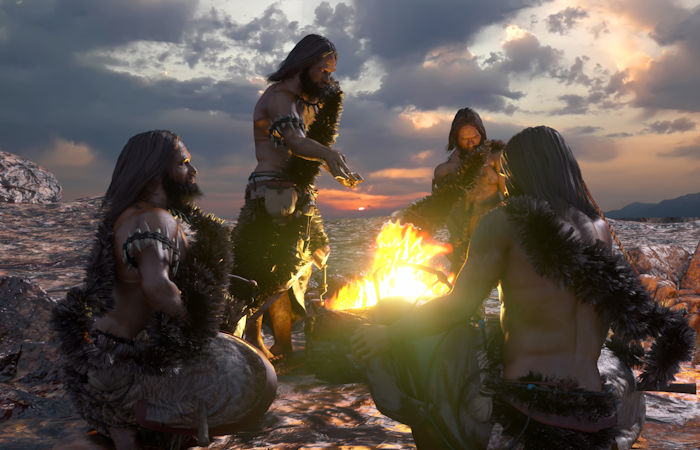The Real Paleo Diet: New Archaeological Evidence Changes What We Thought About How Ancient Humans Prepared Food
AncientPages.com - We humans can't stop playing with our food. Just think of all the different ways of serving potatoes—entire books have been written about potato recipes alone. The restaurant industry was born from our love of flavouring food in new and interesting ways.
Ancient cavemen people sit near a campfire. Credit: Adobe Stock - de Art
My team’s analysis of the oldest charred food remains ever found show that jazzing up your dinner is a human habit dating back at least 70,000 years.
Imagine ancient people sharing a meal. You would be forgiven for picturing people tearing into raw ingredients or maybe roasting meat over a fire as that is the stereotype. But our new study showed both Neanderthals and Homo sapiens had complex diets involving several steps of preparation, and took effort with seasoning and using plants with bitter and sharp flavours.
This degree of culinary complexity has never been documented before for Palaeolithic hunter-gatherers.
Before our study, the earliest known plant food remains in south-west Asia were from a hunter-gatherer site in Jordan roughly dating to 14,400 years ago, reported in 2018.
Scanning Electron Microscope images of carbonised food remains. Left: The bread-like food found in Franchthi Cave. Right: Pulse-rich food fragment from Shanidar Cave with wild pea. Ceren Kabukcu, Author provided
We examined food remains from two late Paleolithic sites, which cover a span of nearly 60,000 years, to look at the diets of early hunter gatherers. Our evidence is based on fragments of prepared plant foods (think burnt pieces of bread, patties and porridge lumps) found in two caves. To the naked eye, or under a low-power microscope, they look like carbonised crumbs or chunks, with fragments of fused seeds. But a powerful scanning electron microscope allowed us to see details of plant cells.
Prehistoric chefs
We found carbonised food fragments in Franchthi Cave (Aegean, Greece) dating to about 13,000-11,500 years ago. At Franchthi Cave we found one fragment from a finely-ground food which might be bread, batter or a type of porridge in addition to pulse seed-rich, coarse-ground foods.
In Shanidar Cave (Zagros, Iraqi Kurdistan), associated with early modern humans around 40,000 years ago and Neanderthals around 70,000 years ago, we also found ancient food fragments. This included wild mustard and terebinth (wild pistachio) mixed into foods. We discovered wild grass seeds mixed with pulses in the charred remains from the Neanderthal layers. Previous studies at Shanidar found traces of grass seeds in the tartar on Neanderthal teeth.
At both sites, we often found ground or pounded pulse seeds such as bitter vetch (Vicia ervilia), grass pea (Lathyrus spp) and wild pea (Pisum spp). The people who lived in these caves added the seeds to a mixture that was heated up with water during grinding, pounding or mashing of soaked seeds.
View of Shanidar Cave in Zagros, Iraqi Kurdistan. Chris Hunt, Author provided
The majority of wild pulse mixes were characterised by bitter tasting mixtures. In modern cooking, these pulses are often soaked, heated and de-hulled (removal of the seed coat) to reduce their bitterness and toxins. The ancient remains we found suggest humans have been doing this for tens of thousands of years. But the fact seed coats weren’t completely removed hints that these people wanted to retain a little of the bitter flavour.
What previous studies showed
The presence of wild mustard, with its distinctive sharp taste, is a seasoning well documented in the Aceramic period (the beginning of village life in the south-west Asia, 8500BC) and later Neolithic sites in the region. Plants such as wild almonds (bitter), terebinth (tannin-rich and oily) and wild fruits (sharp, sometimes sour, sometimes tannin-rich) are pervasive in plant remains from south-west Asia and Europe during the later Paleolithic period (40,000-10,000 years ago). Their inclusion in dishes based on grasses, tubers, meat, fish, would have lent a special flavour to the finished meal. So these plants were eaten for tens of thousands of years across areas thousands of miles apart. These dishes may be the origins of human culinary practices.
Based on the evidence from plants found during this time span, there is no doubt both Neanderthals and early modern humans diets included a variety of plants. Previous studies found food residues trapped in tartar on the teeth of Neanderthals from Europe and south-west Asia which show they cooked and ate grasses and tubers such as wild barley, and medicinal plants. The remains of carbonised plants remains show they gathered pulses and pine nuts.
Plant residues found on grinding or pounding tools from the European later Palaeolithic period suggest early modern humans crushed and roasted wild grass seeds. Residues from an Upper Palaeolithic site in the Pontic steppe, in eastern Europe, shows ancient people pounded tubers before they ate them. Archaeological evidence from South Africa as early as 100,000 years ago indicates Homo sapiens used crushed wild grass seeds.
A Neanderthal hearth found at Shanidar Cave. Graeme Barker, Author provided
While both Neanderthals and early modern humans ate plants, this does not show up as consistently in the stable isotope evidence from skeletons, which tells us about the main sources of protein in diet over the lifetime of a person. Recent studies suggest Neanderthal populations in Europe were top-level carnivores. Studies show Homo sapiens seem to have had a greater diversity in their diet than Neanderthals, with a higher proportion of plants. But we are certain our evidence on the early culinary complexity is the start of many finds from early hunter-gatherer sites in the region.
Written by Ceren Kabukcu, Research Associate in Archaeology, University of Liverpool
Provided by The Conversation
This article is republished from The Conversation under a Creative Commons license. Read the original article.
More From Ancient Pages
-
 Unearthing The Mystery Of The Meaning Of Easter Island’s Moai
Archaeology | Dec 15, 2019
Unearthing The Mystery Of The Meaning Of Easter Island’s Moai
Archaeology | Dec 15, 2019 -
 Mysterious Advanced Underground Civilization And A Secret Society – Astonishing Discovery And Connection – Part 1
Civilizations | Apr 21, 2018
Mysterious Advanced Underground Civilization And A Secret Society – Astonishing Discovery And Connection – Part 1
Civilizations | Apr 21, 2018 -
 Ambition, Greed And Death: The Roman Roots Of ‘Game Of Thrones’
Featured Stories | Jul 2, 2019
Ambition, Greed And Death: The Roman Roots Of ‘Game Of Thrones’
Featured Stories | Jul 2, 2019 -
 On This Day In History: Comet Donati First Observed By Italian Astronomer – On June 2, 1858
News | Jun 2, 2016
On This Day In History: Comet Donati First Observed By Italian Astronomer – On June 2, 1858
News | Jun 2, 2016 -
 Mysterious Utah: Prehistoric Ancient Petroglyphs Of Santa Clara River Reserve
Civilizations | Oct 2, 2018
Mysterious Utah: Prehistoric Ancient Petroglyphs Of Santa Clara River Reserve
Civilizations | Oct 2, 2018 -
 Seven Gods Of Happiness – Bring Luck, Prosperity And Health In Japanese Folk Belief
Featured Stories | Jun 29, 2020
Seven Gods Of Happiness – Bring Luck, Prosperity And Health In Japanese Folk Belief
Featured Stories | Jun 29, 2020 -
 Ancient Oral History Of Lake Babine First Nation Confirmed By Archaeologists
Archaeology | Jan 29, 2019
Ancient Oral History Of Lake Babine First Nation Confirmed By Archaeologists
Archaeology | Jan 29, 2019 -
 Controversial Artifacts No One Wants To Examine Thoroughly: Is There Something We Are Afraid Of Discovering?
Ancient Technology | May 22, 2019
Controversial Artifacts No One Wants To Examine Thoroughly: Is There Something We Are Afraid Of Discovering?
Ancient Technology | May 22, 2019 -
 Ancient Inscriptions Of Babylonian King Nabonidus Discovered In Saudi Arabia
Archaeology | Jul 14, 2021
Ancient Inscriptions Of Babylonian King Nabonidus Discovered In Saudi Arabia
Archaeology | Jul 14, 2021 -
 Why Did People Start Eating Egyptian Mummies? The Weird And Wild Ways Mummy Fever Swept Through Europe
Featured Stories | Jun 7, 2022
Why Did People Start Eating Egyptian Mummies? The Weird And Wild Ways Mummy Fever Swept Through Europe
Featured Stories | Jun 7, 2022 -
 Ancient Secrets Of Mistletoe – Sacred Celtic Plant With Magical Powers
Ancient Traditions And Customs | Dec 2, 2017
Ancient Secrets Of Mistletoe – Sacred Celtic Plant With Magical Powers
Ancient Traditions And Customs | Dec 2, 2017 -
 On This Day In History: World War II: Battle Of Cape Esperance Was Fought – On October 11, 1942
News | Oct 11, 2016
On This Day In History: World War II: Battle Of Cape Esperance Was Fought – On October 11, 1942
News | Oct 11, 2016 -
 Neanderthals And Other Ancient Humans Were Much More Intimate Than Previously Thought – DNA Shows
DNA | Jul 12, 2024
Neanderthals And Other Ancient Humans Were Much More Intimate Than Previously Thought – DNA Shows
DNA | Jul 12, 2024 -
 Remains of Maurya-Era Wall Discovered In Tilaurakot, Kapilvastu, Nepal
Archaeology | Jun 16, 2022
Remains of Maurya-Era Wall Discovered In Tilaurakot, Kapilvastu, Nepal
Archaeology | Jun 16, 2022 -
 Millennial Pre-Colonial Cultural Influence Is Evident In The Amazon Forest
Archaeology | Jun 28, 2020
Millennial Pre-Colonial Cultural Influence Is Evident In The Amazon Forest
Archaeology | Jun 28, 2020 -
 Ancient Marble Statue Of Sphinx Discovered In Tang Dynasty Tomb
Archaeology | Dec 16, 2015
Ancient Marble Statue Of Sphinx Discovered In Tang Dynasty Tomb
Archaeology | Dec 16, 2015 -
 Ancient City Of Babylon Finally Declared A World Heritage Site By UNESCO
Archaeology | Jul 8, 2019
Ancient City Of Babylon Finally Declared A World Heritage Site By UNESCO
Archaeology | Jul 8, 2019 -
 Pyramid Of Djoser May Have Been Constructed Using Hydraulic Lift Technology – Scientists Say
Archaeology | Aug 5, 2024
Pyramid Of Djoser May Have Been Constructed Using Hydraulic Lift Technology – Scientists Say
Archaeology | Aug 5, 2024 -
 What Was Life Like For Children In Ancient Athens?
Ancient History Facts | Jul 4, 2018
What Was Life Like For Children In Ancient Athens?
Ancient History Facts | Jul 4, 2018 -
 Mysterious Lost Civilization Of Tiahuanaco – Uncomfortable Truth About One Of The World’s Oldest Cities
Civilizations | May 24, 2020
Mysterious Lost Civilization Of Tiahuanaco – Uncomfortable Truth About One Of The World’s Oldest Cities
Civilizations | May 24, 2020




